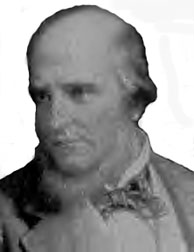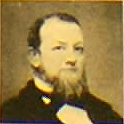When war ends, many people want to return to business as usual as quickly as possible. "Business as usual" in New York City has sometimes meant returning to Tammany Hall-style governmental and political corruption. With the Civil War ended in 1865, Tammany again nominated for mayor City Inspector Francis I. A. Boole whom independent Democrat Gunther had defeated in 1863.
But Boole himself figured as a subject of some inquiry. So Tammany rethought the matter of mayoral nomination and withdrew Boole's name. Instead the Hall designated as its candidate John T. Hoffman, whose handling of the 1863 draft riot cases as Recorder (judge) brought him wide recognition and regard.
Elected as an independent, Mayor Gunther had not developed an organization that could compete with Tammany Hall. Competent, earnest, frugal, and a bit contentious, he was no Fernando Wood whose forceful, crafty and charismatic personality attracted the legions of loyal followers who set up the rival Mozart Hall.
Gunther's beloved volunteer fire companies, being forced into obsolescence by the state law mandating a paid department, no longer had a stake in the election. Their will and interest in promoting particular candidacies declined. The Copperheads, Peace Democrats, and anti-abolitionist forces to whom Gunther had some appeal were apparently in dispirited disarray. No way were they able to mount a creditable campaign on his behalf.

|
MARSHALL O. ROBERTS
A self-made millionaire with wide financial interests in shipping, rails and the Atlantic telegraph cable, he had started as grocer's clerk and a ship chandler's assistant. His ships included the pioneer steamer Hendrik Hudson and the Star of the West. The latter was sent to resupply Fort Sumter. At his own expense, Roberts raised an army of 1,000 he sent aboard his ship America to re-enforce threatened Fort Monroe in 1861. His 1865 unsuccessful race for mayor on the Unity Party ticket (Republicans and others) was his second try for elected office. An 1852 run for Congress as a Whig also was unavailing.
|
Meanwhile, six years of City Hall not being under Tammany's thumb -- that is, the successive administrations of Mozart's Wood, Republican Opdyke and independent Gunther -- had dulled New Yorkers' memory of what Tammany rule really meant. National history and local political memory, it seemed, had moved elsewhere, leaving Gunther behind.
Nevertheless, what was left of the so-called McKeon Democracy that had come into being as an anti-Tammany and peace party nominated Gunther for re-election. The McKeon Democracy, a reform-minded wing of the New York Democratic Party, had been formed in reaction to excesses associated with Fernando Wood and Wood's influence within and over Tammany. One of the highly regarded leaders of the anti-Wood movement was John McKeon, a former Assemblyman, former Congressman, former District Attorney, and former US Attorney for the Southern District. The Gunther administration had been relatively clean, as measured by the then prevailing New York City standards of political morality. Although, with the election neared, some opposition press made noises about irregularities in street cleaning contracts, the allegations never went beyond newspaper ink.
The Republicans nominated Marshall O. Roberts whose rise from grocery clerk to millionaire shipping tycoon had a certain popular appeal. Wood's Mozart Hall nominated a relative unknown, John Hecker.
Gunther came in a poor fourth in the poll tallies: only 6,728 votes whereas Roberts came within 1,164 shy of finishing first. He received 31,657 to Hoffman's 32,820. Hecker gathered 10,390. What a difference two tears had made for Gunther -- from winning the mayoralty in 1863 by a margin of more than 6,000 votes to receiving in 1865 only about that number as his total vote!
Release from the demands of public office gave Gunther the opportunity to concentrate on other pursuits. In 1868, he was named president of the German Hospital that a half century later would take on as its name that of its neighborhood: Lenox Hill.
The medical institution was founded in 1857 as the German Dispensary at 132 Canal Street. Dr. Abraham Jacobi, considered the father of American pediatrics, and Carl Schurz, an American statesman, were among its early founders and supporters. On September 3, 1866, it moved uptown as the cornerstone for a new 80-bed facility to be called German Hospital and Dispensary was laid at 77th St. and Fourth Ave. (now Park Avenue). The site was near a farm owned by Robert Lenox. As homes began to line the streets near the German Hospital, the area became identified with the farm that once had been its landmark. In 1918, Lenox Hill Hospital assumed its current name.

|
Millions of beach-bound NYers and non-NYers rode Gunther's steam railroad to Coney Island.
|
Among the business affairs to which he could devote more attention than had been possible while mayor was his interest in suburban railroading. He had been among the first to see in Coney Island great potential as recreation destination. He undertook having the first steam railroad to the beach constructed. The route -- from Greenwood Cemetery to Coney Island -- went through the farmlands of Borough Park, Gravesend and New Utrecht, a fact that riled the local farmers.
The line known as Gunther's Road (and later the West End Line) apparently proved more successful than two hotels he had erected in the area: the Tivoli at Coney Island and the Locust Grove at Gravesend. The latter burnt down and the former never made much profit. Gunther had a habit of naming the new engine trains he bought after his children. Sons Christopher and George and daughters, Meme and Maud, had engines named for them.
The steam railroad was originally the Brooklyn, Bath and Coney Island Railroad and later became the Bath Beach and West End Line. It eventually was electrified and elevated. The old "B" line and current "M" and "W" lines can trace parts of their routes/roots back to Gunther's Road.
In 1878, Gunther attempted a political comeback by running for the state senate seat from the 7th district but was defeated. He died seven years later -- on Jan. 22, 1885 -- at his Manhattan home and was buried in Greenwood Cemetery, Brooklyn, not far from where his railroad line had begun.



